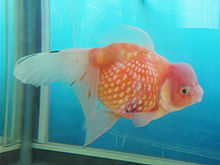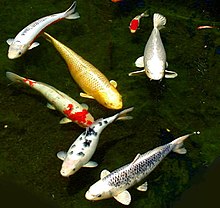Carp: Difference between revisions
m Reverting possible vandalism by 86.139.193.15 to version by Geronimo20. False positive? Report it. Thanks, ClueBot. (824422) (Bot) |
Sethwenger (talk | contribs) Not all species of carp are listed as invasives in U.S.; No particular reason to emphasize the MN listing; "billions" should have attribution. |
||
| Line 27: | Line 27: | ||
and others |
and others |
||
}} |
}} |
||
'''Carp''' is a common name for various species of an [[oily fish|oily]]<ref>{{cite article|url=http://www.food.gov.uk/news/newsarchive/2004/jun/oilyfishdefinition|title=What's an oily fish?|date=2004-06-24|publisher=[[Food Standards Agency]]}}</ref> [[freshwater fish]] of the family [[Cyprinidae]], a very large group of fish native to Europe and Asia. Some consider all cyprinid fishes carp, and the family Cyprinidae itself is often known as the carp family. In colloquial use, however, carp usually refers only to several larger cyprinid species such as ''[[Cyprinus carpio]]'' (common carp), ''[[Carassius carassius]]'' (Crucian carp), ''[[Ctenopharyngodon idella]]'' (grass carp), ''[[Hypophthalmichthys molitrix]]'' (silver carp), and ''[[Hypophthalmichthys nobilis]]'' (bighead carp). Carp have long been an important food fish to humans, as well as popular ornamental fishes such as the various [[goldfish]] breeds and the domesticated common carp variety known as [[koi]]. As a result, carp have been introduced to various locations, though with mixed results. |
'''Carp''' is a common name for various species of an [[oily fish|oily]]<ref>{{cite article|url=http://www.food.gov.uk/news/newsarchive/2004/jun/oilyfishdefinition|title=What's an oily fish?|date=2004-06-24|publisher=[[Food Standards Agency]]}}</ref> [[freshwater fish]] of the family [[Cyprinidae]], a very large group of fish native to Europe and Asia. Some consider all cyprinid fishes carp, and the family Cyprinidae itself is often known as the carp family. In colloquial use, however, carp usually refers only to several larger cyprinid species such as ''[[Cyprinus carpio]]'' (common carp), ''[[Carassius carassius]]'' (Crucian carp), ''[[Ctenopharyngodon idella]]'' (grass carp), ''[[Hypophthalmichthys molitrix]]'' (silver carp), and ''[[Hypophthalmichthys nobilis]]'' (bighead carp). Carp have long been an important food fish to humans, as well as popular ornamental fishes such as the various [[goldfish]] breeds and the domesticated common carp variety known as [[koi]]. As a result, carp have been introduced to various locations, though with mixed results. Several species of carp are listed as invasive species by the U.S. Department of Agriculture (http://www.invasivespeciesinfo.gov/aquatics/asiancarp.shtml), and worldwide large sums of money are spent on carp control. |
||
==Aquaculture== |
==Aquaculture== |
||
Revision as of 20:16, 21 November 2009
| Carp | |
|---|---|

| |
| Common carp, Cyprinus carpio | |
| Scientific classification | |
| Kingdom: | |
| Phylum: | |
| Class: | |
| Order: | |
| Family: | |
| Genera | |
|
Abramis | |
Carp is a common name for various species of an oily[1] freshwater fish of the family Cyprinidae, a very large group of fish native to Europe and Asia. Some consider all cyprinid fishes carp, and the family Cyprinidae itself is often known as the carp family. In colloquial use, however, carp usually refers only to several larger cyprinid species such as Cyprinus carpio (common carp), Carassius carassius (Crucian carp), Ctenopharyngodon idella (grass carp), Hypophthalmichthys molitrix (silver carp), and Hypophthalmichthys nobilis (bighead carp). Carp have long been an important food fish to humans, as well as popular ornamental fishes such as the various goldfish breeds and the domesticated common carp variety known as koi. As a result, carp have been introduced to various locations, though with mixed results. Several species of carp are listed as invasive species by the U.S. Department of Agriculture (http://www.invasivespeciesinfo.gov/aquatics/asiancarp.shtml), and worldwide large sums of money are spent on carp control.
Aquaculture
Carp can be very harmful to other types of freshwater fish. They may feed on the oxygen-producing vegetation in a body of water, thus making it difficult for other species to live there. In areas that are distant from the sea, carp may be the most common fish eaten [citation needed]; although the prevalence of inexpensive frozen fish products have made them less important.
Various species of carp have been domesticated and reared as food fish across Europe and Asia for thousands of years. These various species appear to have been domesticated independently, as the various domesticated carp species are native to different parts of Eurasia. For example, the Common carp Cyprinus carpio are originally from Central Europe.[2] Several carp species (collectively known as Asian carps) were domesticated in East Asia. Carp that are originally from South Asia, for example catla (Gibelion catla), rohu (Labeo rohita) and mrigal (Cirrhinus cirrhosus), are known as Indian carps. Their hardiness and adaptability have allowed domesticated species to be propagated all around the world.
As ornamental fish

Carp, along with many of their cyprinid relatives, are popular ornamental aquarium and pond fish. The two most notable ornamental carps are goldfish and koi. Goldfish and koi have advantages over most other ornamental fishes, in that they are tolerant of cold (they can survive in water temperatures as low as 4 degrees Celsius), can survive at low oxygen levels, and can tolerate low water quality.

Goldfish (Carassius auratus) were originally domesticated from the Prussian carp (Carassius gibelio), a dark greyish brown carp native to Asia. They were first bred for color in China over a thousand years ago. Due to selective breeding, goldfish have been developed into many distinct breeds and are found in various colors, color patterns, forms and sizes far different from those of the original carp. Goldfish were kept as ornamental fish in China for hundreds of years before being introduced to Japan in the 15th century, and to Europe in the late 17th century.
Koi are a domesticated variety of common carp (Cyprinus carpio) that have been selectively culled for color. The common carp was introduced from China to Japan, where selective breeding of the common carp in the 1820s in the Niigata region resulted in koi.[3] In Japanese culture, koi are treated with affection, and seen as good luck. They are popular in other parts of the world as outdoor pond fish.
As sport fish

Izaak Walton said about carp in The Compleat Angler, "The Carp is the queen of rivers; a stately, a good, and a very subtil fish; that was not at first bred, nor hath been long in England, but is now naturalised."
Carp are variable in terms of angling value.
- In Europe, even when not fished for food, they are eagerly sought by anglers, being considered highly prized coarse fish that are difficult to hook.[4] The UK has a thriving carp angling market.
- In the United States, the carp is also classified as a rough fish as well as damaging naturalized exotic species but with sporting qualities. Many states' departments of natural resources are beginning to view the carp as an angling fish instead of a maligned pest. Groups such as the Carp Anglers Group and American Carp Society promote the sport and work with fisheries departments to educate.
Types of carp

- Genus Abramis
- Carp bream (Abramis brama)
- Genus Barbodes:
- Carnatic carp (Barbodes carnaticus)
- Genus Carassius:
- Crucian carp (Carassius carassius )
- Prussian carp or Gibel carp (Carassius gibelio)
- Goldfish (Carassius auratus)
- Genus Cirrhinus:
- Chinese mud carp (Cirrhinus chinensis)
- Deccan white carp (Cirrhinus fulungee)
- Hora white carp (Cirrhinus macrops)
- Small scale mud carp (Cirrhinus microlepis)
- Mud carp (Cirrhinus molitorella)
- Man carp (Cirrhinus saprian)
- Genus Ctenopharyngodon:
- Grass carp (Ctenopharyngodon idellus)
- Genus Culter:
- Predatory carp (Culter erythropterus)
- Genus Cyprinus:
- Common carp, European carp, Koi (Cyprinus carpio)
- Genus Epalzeorhynchos:
- Red-tailed black shark (Epalzeorhynchos bicolor)
- Red-finned black shark or Rainbow shark (Epalzeorhynchos frenatus)
- Genus Henicorhynchus:
- Siamese mud carp (Henicorhynchus siamensis)
- Genus Hypophthalmichthys:
- Bighead carp (Hypophthalmichthys nobilis)
- Silver carp (Hypophthalmichthys molitrix)
- Genus Labeo:
- African carp (Labeo coubie)
- Fringed-lipped peninsula carp (Labeo fimbriatus)
- Bigmouth carp (Labeo kontius)
- Genus Mylopharyngodon:
- Black carp (Mylopharyngodon piceus)
- Genus Tinca:
- Tench (Tinca tinca)
See also
References
- ^ Template:Cite article
- ^ "SpringerLink - Journal Article". www.springerlink.com. Retrieved 2009-05-05.
- ^ http://www.mpks.org/articles/RayJordan/KoiHistory3.shtml
- ^ A. F. Magri MacMahon (1946). Fishlore, pp 149-152. Pelican Books.
External links
- Chistiakov D, Voronova N (2009). "Genetic evolution and diversity of common carp Cyprinus carpio L.". Cent. Eur. J. Biol. 4 (3): 304–312. doi:10.2478/s11535-009-0024-2.



